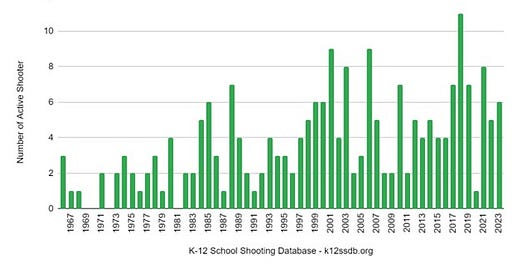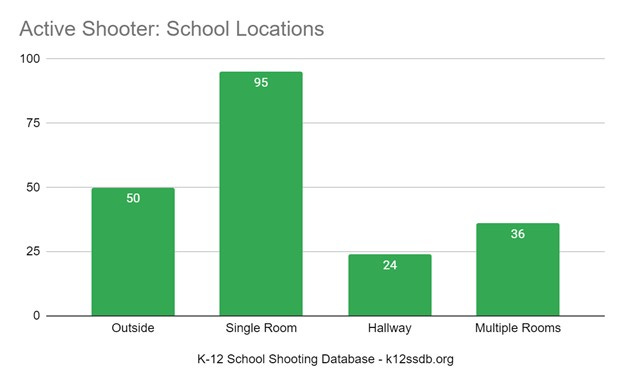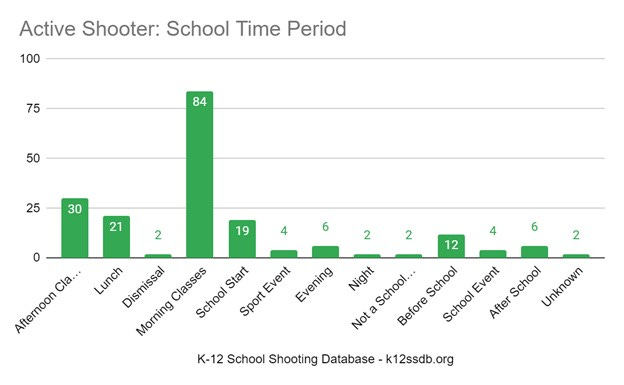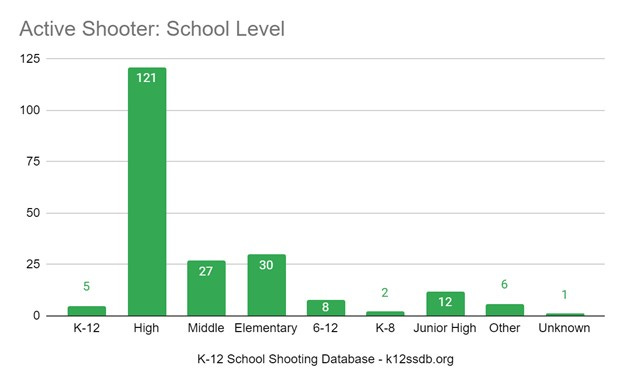"Active Shooter" combines and confuses multiple distinct types of attacks
Using the same terminology for diverse circumstances can lead to a failure in planning, training, and response procedures, as specific tactics required for each situation may be completely different.
Even though schools have “active shooter plan”, police are dispatched to respond for an “active shooter”, and students practice “active shooter” drills, the term "active shooter" lacks a consistent definition. If you asked ten police chiefs and ten schools principals to define “active shooter”, you would get an array of different answers. This is because the concept of an “active shooter” actually encompasses various attack types that are distinct from each other.
Typically, attacks earn the designation of an "active shooter" when the assailant intentionally inflicts harm, causing fatalities and/or injuries to as many victims as possible, deliberately or at random. These acts unfold at a school campus, business, or public space during sustained episode of violence (unlike a serial killer targeting victims in different locations over weeks, months, or years).
Unlike violence targeted at a specific individual, ‘active shooters’ means that they often continue shooting until they are subdued, cornered, or apprehended by school staff, fellow students, or law enforcement.
This definition aligns the term "active shooter" by combining elements from the FBI's definition with distinctions found in homicide literature. This differentiation considers the act as a rampage killing rather than a traditional homicide, family annihilation, or episodic serial killing.
School shootings and mass public shootings rarely occur at random locations. Instead, the choice to attack a school typically holds symbolic significance for the perpetrator. Frequently, the shooter is a current or former student who has experienced unresolved trauma, leading to a profound grievance that they believe can only be resolved through indiscriminate violence (Peterson & Densley, 2021).
Various definitions exist for terms like mass killer, serial killer, rampage killer, active shooter, and school shooter, as outlined by researchers such as Madfis (2020), Newman (2004), Duwe (2007), Fox (2018), and official agencies like the FBI, USSS, and DOJ.
It's essential to note that there is no established legal definition or specific criminal charges assigned to an "active shooter," "mass shooter," or "school shooter."
Different Types of Deliberate Attacks at Schools
Insider (or multi-insiders) Attacks:
A surprise attack designed to inflict maximum casualties, targeting both specific and random victims.
The perpetrator utilizes insider knowledge to bypass or overcome security measures.
Emphasis on a symbolic target location that resonates with the shooter's grievances.
Example: In December 2019 at Saugus High, Santa Clarita, CA, a high-achieving student with no disciplinary history executed an attack during a class change, firing indiscriminately at a crowd of students in the school courtyard. Five classmates were injured before the shooter took his own life in a mere 16 seconds from the first to last bullet being fired.
Frontal Assault:
An attack on a fixed target without permission to enter.
Example: In October 2022 at Central Visual Performing Arts High, St. Louis, MO, a former student armed with a semi-auto rifle and 600 rounds forcibly entered the school by breaking a window of a locked side door. Proceeding to the third floor, the assailant opened fire on students in the hallway, injuring six—two fatally. After barricading himself in a third-floor classroom, he was eventually killed by the police. Some students resorted to jumping from third-story windows to escape the danger, with over 200 rounds discharged inside the school.
Sniper Attack:
Firing upon a fixed target from a distance beyond the security perimeter.
Example: In April 2022 at Edmund Burke School, Washington, DC, a 23-year-old man fired a rifle at students on a glass pedestrian bridge from his fifth-floor apartment across the street. Sixty shots were discharged in 18 seconds, resulting in injuries to a student on the bridge, a school security guard, a parent in a waiting vehicle, and another adult pedestrian. The shooter, armed with six firearms, including rifles modified for automatic fire, took his own life when the police raided his residence. The entire incident was live-streamed with a camera inside the rifle scope, and the shooter edited the Edmund Burke School Wikipedia page during the police response.
Assassination or Ambush:
Targeted killing of specific individual(s) due to the shooter's knowledge of their presence at the school.
Example: In October 2021 at YES Prep, Houston, TX, a 25-year-old former student attempted entry by breaking glass doors. Shots were fired down the hallway at the school principal. The school went on lockdown, and the shooter surrendered to the police, revealing a history of mental illness and auditory hallucinations. The shooter clarified to the police that the principal was not his target; he was seeking another staff member. No students were harmed.
Hostage-Taking:
Taking hostages based on ideology, grievances, or financial motives (ransom).
Example: In September 2012 at Normal Community High School, Normal, IL, a 14-year-old student, carrying three handguns, a knife, and a hatchet, took a classroom hostage, citing personal struggles and experiences of bullying. The teacher intervened, tackling the student when he momentarily lowered his gun and preventing further harm.
Barricade:
Entering a facility and maintaining a defensive position without taking hostages.
Example: In February 2018 at Dalton High School, Dalton, GA, a teacher barricaded himself in a classroom, warning of possessing a gun. After firing a shot, the school resource officer negotiated with the teacher, leading to a peaceful surrender without harm to students, staff, or officers.
Complex Coordinated Attack:
A hybrid involving any combination of attack types.
Example: In December 2013 at Arapahoe High School, Centennial, CO, a student entered the school with a shotgun, Molotov cocktails, and extra ammunition. After firing shots and throwing a Molotov cocktail, he confronted a school resource officer and subsequently committed suicide. The intended target appeared to be the librarian, who sponsored the debate team of which the shooter was a member.
Deliberate Attacks at Schools Since 1966
Since 1966, a total of 213 attacks have occurred at K–12 schools, meeting the general definition of an "active shooter" incident where the perpetrator killed and/or wounded victims within the school campus, business, or public space during a continuous episode of violence.
A closer examination of these incidents reveals uneven distribution across the different attack types. Over half of the planned school shootings are single-shooter insider attacks or deliberate hostage-taking. Contrary to common training scenarios involving a second shooter or complex coordinated plots with secondary attacks, a surprise attack by an insider is overwhelmingly the most common occurrence.
Surprisingly, sniper attacks, which are infrequently trained for, are twice as likely as complex coordinated plots. An example includes an incident in April 2022, where a sniper fired over 200 rounds from a fifth-floor apartment at the Edmund Burke School in Washington, DC, just before dismissal—an event rarely simulated in school shooting training exercises.
Many school security plans and equipment focus on preventing shooters from moving between multiple classrooms. While fortifications were not prevalent in most early school shootings, approximately half of the incidents were contained within a single room. Only 17% of the shooters targeted victims in multiple rooms, and in 50 of the 213 shootings, the attacks occurred outside, with the shooter never entering the building.
Planned attacks at schools most commonly take place during morning classes, with 31 attacks occurring before the school opened or right at opening, potentially when doors may still be locked. An illustrative example is the Marshall County High shooting in Benton, KY, where a 15-year-old student carried out a planned attack before classes began, resulting in two deaths and 18 injuries.
These planned attacks are predominantly executed by current or former students with a direct connection to the campus. Given that students capable of planning such attacks tend to be older teens, about two-thirds of these deliberate school shootings occur at high schools or combined K–12 and 6–12 grade schools.
Roughly 14% of active shooters target elementary or middle schools, with some middle-school attacks carried out by younger teens, as evidenced by the Westside Middle School incident in Jonesboro, AR, where two male students, aged 13 and 11, initiated a planned attack by pulling the fire alarm and targeting their fellow students during evacuation. The assailants possessed nine stolen weapons and 2,000 rounds of ammunition obtained from a grandparent's house.
What this means for schools
The enhancement of school security typically falls within two main categories:
Physical Building Hardening: This involves measures such as locking doors, installing metal detectors, ballistic shields and glass, additional cameras, and other similar physical measures.
Increased Campus Policing: This strategy involves increasing the presence of law enforcement or armed staff on campus.
However, both of these strategies prove ineffective against certain attack scenarios, including insiders with authorized access to the school (38%), snipers operating from a distance (10%), and frontal assaults where an armed individual forcefully enters (12%).
In instances of the 10 identified complex coordinated plots, the attack plans were designed to manipulate the movement of students and staff away from the building or direct victims toward improvised explosive devices (IEDs) and flammable liquid devices. In these cases, even a fortified school building with on-campus officers would not suffice to prevent the school shooting.
The fundamental issue contributing to misaligned security investments and strategies lies in the use of blanket terms like "active shooter" and "school shooting" to describe a range of attack types. When security strategies are formulated based on broad categories rather than the specifics of different attack types, their effectiveness can vary significantly.
Path Forward for Better Planning
Recognizing each of the distinct attack types as unique scenarios is crucial for police and school officials to prepare for and respond to a school shooting. Each scenario demands its own set of plans and procedures for effective security.
Focusing too much attention on what happened last time, or what someone imagines might happen in the future, can distract us from the actual data. For example, hostages are often completely overlooked in planning and training processes. From looking at data on 60 years of school shootings, 72% of the 43 hostage situations were successfully negotiated one or zero victims being wounded or killed. The conventional active-shooter response, instructing individuals to "run to the sound of gunfire," may exacerbate situations that could otherwise be resolved peacefully during a hostage scenario.
These data-driven findings underscore the critical importance of tailoring emergency responses and protective actions to the specific characteristics of each attack scenario. In the absence of comprehensive planning and training for each of the different scenarios, the potential consequences of responding to a sniper and insider in exactly the same way can be disastrous.
David Riedman is the creator of the K-12 School Shooting Database and a national expert on school shootings. Listen to my recent interviews on Freakonomics Radio and the New England Journal of Medicine.








